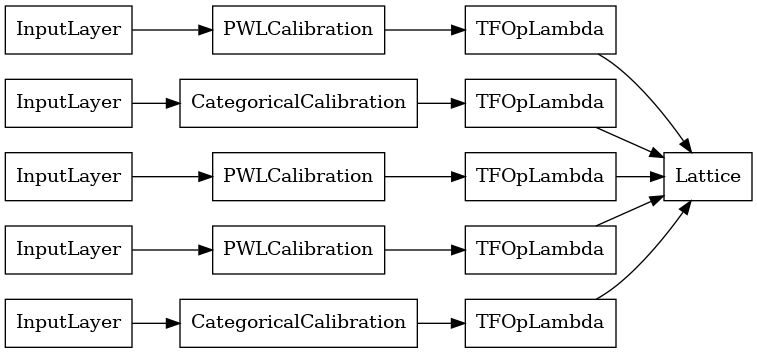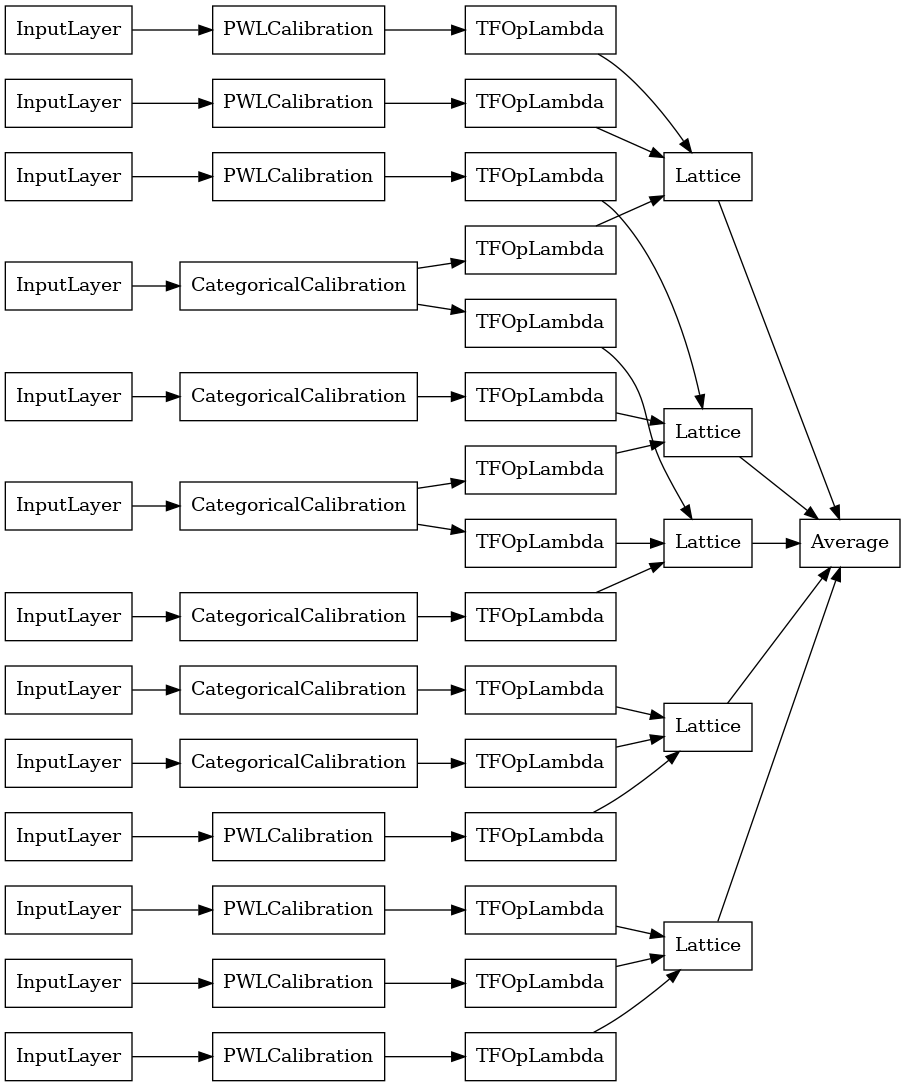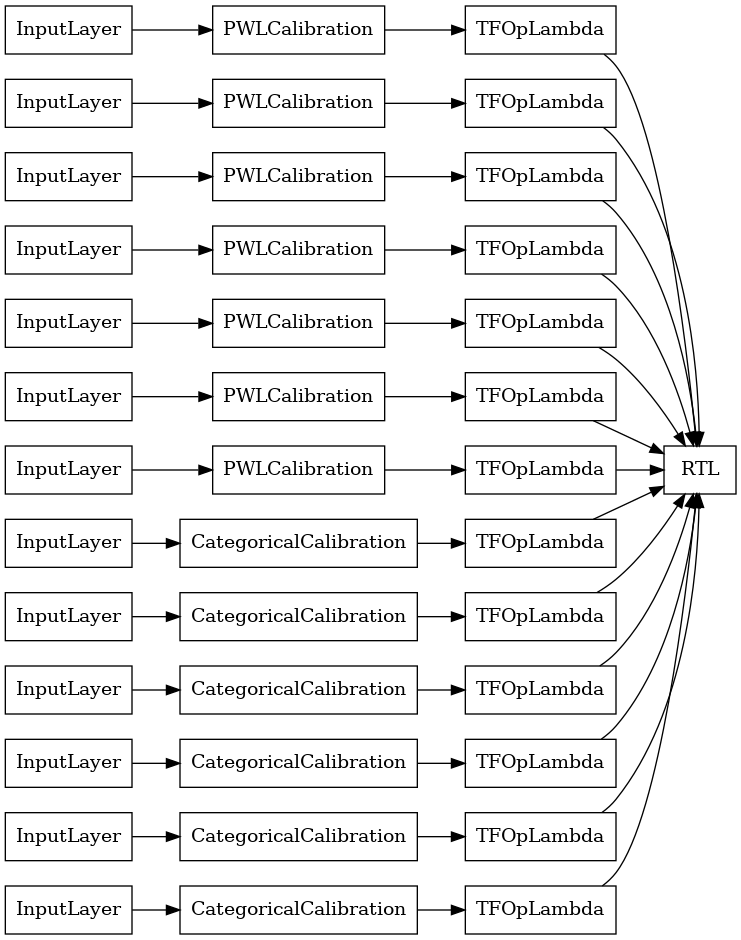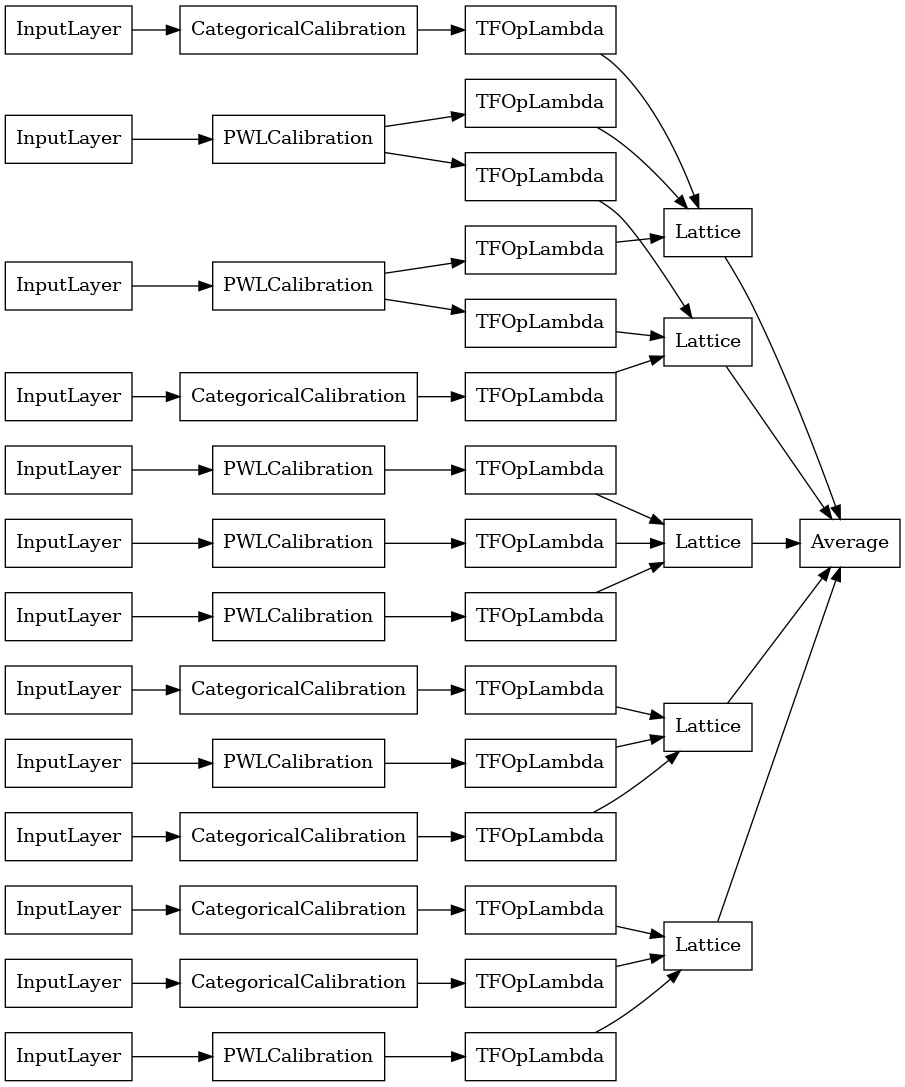 在 TensorFlow.org 上查看 在 TensorFlow.org 上查看
|
 在 Google Colab 中运行 在 Google Colab 中运行
|
 在 GitHub 上查看源代码 在 GitHub 上查看源代码
|
 下载笔记本 下载笔记本
|
概述
预制模型是构建 TFL keras.Model 实例以用于典型用例的快速简便方法。本指南概述了构建 TFL 预制模型并对其进行训练/测试所需的步骤。
设置
安装 TF Lattice 包
pip install --pre -U tensorflow tf-keras tensorflow-lattice pydot graphviz
导入所需的包
import tensorflow as tf
import copy
import logging
import numpy as np
import pandas as pd
import sys
import tensorflow_lattice as tfl
logging.disable(sys.maxsize)
# Use Keras 2.
version_fn = getattr(tf.keras, "version", None)
if version_fn and version_fn().startswith("3."):
import tf_keras as keras
else:
keras = tf.keras
设置本指南中用于训练的默认值
LEARNING_RATE = 0.01
BATCH_SIZE = 128
NUM_EPOCHS = 500
PREFITTING_NUM_EPOCHS = 10
下载 UCI Statlog (Heart) 数据集
heart_csv_file = keras.utils.get_file(
'heart.csv',
'http://storage.googleapis.com/download.tensorflow.org/data/heart.csv')
heart_df = pd.read_csv(heart_csv_file)
thal_vocab_list = ['normal', 'fixed', 'reversible']
heart_df['thal'] = heart_df['thal'].map(
{v: i for i, v in enumerate(thal_vocab_list)})
heart_df = heart_df.astype(float)
heart_train_size = int(len(heart_df) * 0.8)
heart_train_dict = dict(heart_df[:heart_train_size])
heart_test_dict = dict(heart_df[heart_train_size:])
# This ordering of input features should match the feature configs. If no
# feature config relies explicitly on the data (i.e. all are 'quantiles'),
# then you can construct the feature_names list by simply iterating over each
# feature config and extracting it's name.
feature_names = [
'age', 'sex', 'cp', 'chol', 'fbs', 'trestbps', 'thalach', 'restecg',
'exang', 'oldpeak', 'slope', 'ca', 'thal'
]
# Since we have some features that manually construct their input keypoints,
# we need an index mapping of the feature names.
feature_name_indices = {name: index for index, name in enumerate(feature_names)}
label_name = 'target'
heart_train_xs = [
heart_train_dict[feature_name] for feature_name in feature_names
]
heart_test_xs = [heart_test_dict[feature_name] for feature_name in feature_names]
heart_train_ys = heart_train_dict[label_name]
heart_test_ys = heart_test_dict[label_name]
特征配置
使用 tfl.configs.FeatureConfig 设置特征校准和每个特征的配置。特征配置包括单调性约束、每个特征的正则化(参见 tfl.configs.RegularizerConfig)以及网格模型的网格大小。
请注意,我们必须为模型要识别的任何特征完全指定特征配置。否则,模型将无法知道该特征的存在。
定义我们的特征配置
现在我们可以计算分位数,为模型要作为输入的每个特征定义特征配置。
# Features:
# - age
# - sex
# - cp chest pain type (4 values)
# - trestbps resting blood pressure
# - chol serum cholestoral in mg/dl
# - fbs fasting blood sugar > 120 mg/dl
# - restecg resting electrocardiographic results (values 0,1,2)
# - thalach maximum heart rate achieved
# - exang exercise induced angina
# - oldpeak ST depression induced by exercise relative to rest
# - slope the slope of the peak exercise ST segment
# - ca number of major vessels (0-3) colored by flourosopy
# - thal normal; fixed defect; reversable defect
#
# Feature configs are used to specify how each feature is calibrated and used.
heart_feature_configs = [
tfl.configs.FeatureConfig(
name='age',
lattice_size=3,
monotonicity='increasing',
# We must set the keypoints manually.
pwl_calibration_num_keypoints=5,
pwl_calibration_input_keypoints='quantiles',
pwl_calibration_clip_max=100,
# Per feature regularization.
regularizer_configs=[
tfl.configs.RegularizerConfig(name='calib_wrinkle', l2=0.1),
],
),
tfl.configs.FeatureConfig(
name='sex',
num_buckets=2,
),
tfl.configs.FeatureConfig(
name='cp',
monotonicity='increasing',
# Keypoints that are uniformly spaced.
pwl_calibration_num_keypoints=4,
pwl_calibration_input_keypoints=np.linspace(
np.min(heart_train_xs[feature_name_indices['cp']]),
np.max(heart_train_xs[feature_name_indices['cp']]),
num=4),
),
tfl.configs.FeatureConfig(
name='chol',
monotonicity='increasing',
# Explicit input keypoints initialization.
pwl_calibration_input_keypoints=[126.0, 210.0, 247.0, 286.0, 564.0],
# Calibration can be forced to span the full output range by clamping.
pwl_calibration_clamp_min=True,
pwl_calibration_clamp_max=True,
# Per feature regularization.
regularizer_configs=[
tfl.configs.RegularizerConfig(name='calib_hessian', l2=1e-4),
],
),
tfl.configs.FeatureConfig(
name='fbs',
# Partial monotonicity: output(0) <= output(1)
monotonicity=[(0, 1)],
num_buckets=2,
),
tfl.configs.FeatureConfig(
name='trestbps',
monotonicity='decreasing',
pwl_calibration_num_keypoints=5,
pwl_calibration_input_keypoints='quantiles',
),
tfl.configs.FeatureConfig(
name='thalach',
monotonicity='decreasing',
pwl_calibration_num_keypoints=5,
pwl_calibration_input_keypoints='quantiles',
),
tfl.configs.FeatureConfig(
name='restecg',
# Partial monotonicity: output(0) <= output(1), output(0) <= output(2)
monotonicity=[(0, 1), (0, 2)],
num_buckets=3,
),
tfl.configs.FeatureConfig(
name='exang',
# Partial monotonicity: output(0) <= output(1)
monotonicity=[(0, 1)],
num_buckets=2,
),
tfl.configs.FeatureConfig(
name='oldpeak',
monotonicity='increasing',
pwl_calibration_num_keypoints=5,
pwl_calibration_input_keypoints='quantiles',
),
tfl.configs.FeatureConfig(
name='slope',
# Partial monotonicity: output(0) <= output(1), output(1) <= output(2)
monotonicity=[(0, 1), (1, 2)],
num_buckets=3,
),
tfl.configs.FeatureConfig(
name='ca',
monotonicity='increasing',
pwl_calibration_num_keypoints=4,
pwl_calibration_input_keypoints='quantiles',
),
tfl.configs.FeatureConfig(
name='thal',
# Partial monotonicity:
# output(normal) <= output(fixed)
# output(normal) <= output(reversible)
monotonicity=[('normal', 'fixed'), ('normal', 'reversible')],
num_buckets=3,
# We must specify the vocabulary list in order to later set the
# monotonicities since we used names and not indices.
vocabulary_list=thal_vocab_list,
),
]
设置单调性和关键点
接下来,我们需要确保为使用自定义词汇表(如上面的“thal”)的特征正确设置单调性。
tfl.premade_lib.set_categorical_monotonicities(heart_feature_configs)
最后,我们可以通过计算和设置关键点来完成我们的特征配置。
feature_keypoints = tfl.premade_lib.compute_feature_keypoints(
feature_configs=heart_feature_configs, features=heart_train_dict)
tfl.premade_lib.set_feature_keypoints(
feature_configs=heart_feature_configs,
feature_keypoints=feature_keypoints,
add_missing_feature_configs=False)
校准线性模型
要构建 TFL 预制模型,首先从 tfl.configs 中构建模型配置。使用 tfl.configs.CalibratedLinearConfig 构建校准线性模型。它对输入特征应用分段线性校准和分类校准,然后进行线性组合,并可选地进行输出分段线性校准。使用输出校准或指定输出边界时,线性层将对校准后的输入应用加权平均。
此示例在头 5 个特征上创建校准线性模型。
# Model config defines the model structure for the premade model.
linear_model_config = tfl.configs.CalibratedLinearConfig(
feature_configs=heart_feature_configs[:5],
use_bias=True,
output_calibration=True,
output_calibration_num_keypoints=10,
# We initialize the output to [-2.0, 2.0] since we'll be using logits.
output_initialization=np.linspace(-2.0, 2.0, num=10),
regularizer_configs=[
# Regularizer for the output calibrator.
tfl.configs.RegularizerConfig(name='output_calib_hessian', l2=1e-4),
])
# A CalibratedLinear premade model constructed from the given model config.
linear_model = tfl.premade.CalibratedLinear(linear_model_config)
# Let's plot our model.
keras.utils.plot_model(linear_model, show_layer_names=False, rankdir='LR')
2024-03-23 11:24:50.795913: E external/local_xla/xla/stream_executor/cuda/cuda_driver.cc:282] failed call to cuInit: CUDA_ERROR_NO_DEVICE: no CUDA-capable device is detected

现在,与任何其他 keras.Model 一样,我们将编译模型并将其拟合到我们的数据。
linear_model.compile(
loss=keras.losses.BinaryCrossentropy(from_logits=True),
metrics=[keras.metrics.AUC(from_logits=True)],
optimizer=keras.optimizers.Adam(LEARNING_RATE))
linear_model.fit(
heart_train_xs[:5],
heart_train_ys,
epochs=NUM_EPOCHS,
batch_size=BATCH_SIZE,
verbose=False)
<tf_keras.src.callbacks.History at 0x7f2e340ce580>
训练完模型后,我们可以在测试集上对其进行评估。
print('Test Set Evaluation...')
print(linear_model.evaluate(heart_test_xs[:5], heart_test_ys))
Test Set Evaluation... 2/2 [==============================] - 1s 7ms/step - loss: 0.4746 - auc: 0.8271 [0.47455987334251404, 0.8270676732063293]
校准网格模型
使用 tfl.configs.CalibratedLatticeConfig 构建校准网格模型。校准网格模型对输入特征应用分段线性校准和分类校准,然后进行网格模型,并可选地进行输出分段线性校准。
此示例在头 5 个特征上创建校准网格模型。
# This is a calibrated lattice model: inputs are calibrated, then combined
# non-linearly using a lattice layer.
lattice_model_config = tfl.configs.CalibratedLatticeConfig(
feature_configs=heart_feature_configs[:5],
# We initialize the output to [-2.0, 2.0] since we'll be using logits.
output_initialization=[-2.0, 2.0],
regularizer_configs=[
# Torsion regularizer applied to the lattice to make it more linear.
tfl.configs.RegularizerConfig(name='torsion', l2=1e-2),
# Globally defined calibration regularizer is applied to all features.
tfl.configs.RegularizerConfig(name='calib_hessian', l2=1e-2),
])
# A CalibratedLattice premade model constructed from the given model config.
lattice_model = tfl.premade.CalibratedLattice(lattice_model_config)
# Let's plot our model.
keras.utils.plot_model(lattice_model, show_layer_names=False, rankdir='LR')

与之前一样,我们将编译、拟合和评估我们的模型。
lattice_model.compile(
loss=keras.losses.BinaryCrossentropy(from_logits=True),
metrics=[keras.metrics.AUC(from_logits=True)],
optimizer=keras.optimizers.Adam(LEARNING_RATE))
lattice_model.fit(
heart_train_xs[:5],
heart_train_ys,
epochs=NUM_EPOCHS,
batch_size=BATCH_SIZE,
verbose=False)
print('Test Set Evaluation...')
print(lattice_model.evaluate(heart_test_xs[:5], heart_test_ys))
Test Set Evaluation... 2/2 [==============================] - 1s 8ms/step - loss: 0.4731 - auc_1: 0.8327 [0.47311311960220337, 0.8327068090438843]
校准网格集成模型
当特征数量很大时,可以使用集成模型,该模型为特征子集创建多个较小的网格,并对其输出进行平均,而不是只创建一个巨大的网格。集成网格模型使用 tfl.configs.CalibratedLatticeEnsembleConfig 构建。校准网格集成模型对输入特征应用分段线性校准和分类校准,然后进行网格模型集成,并可选地进行输出分段线性校准。
显式网格集成初始化
如果您已经知道要将哪些特征子集馈送到网格中,那么可以使用特征名称显式设置网格。此示例创建一个校准网格集成模型,该模型具有 5 个网格,每个网格有 3 个特征。
# This is a calibrated lattice ensemble model: inputs are calibrated, then
# combined non-linearly and averaged using multiple lattice layers.
explicit_ensemble_model_config = tfl.configs.CalibratedLatticeEnsembleConfig(
feature_configs=heart_feature_configs,
lattices=[['trestbps', 'chol', 'ca'], ['fbs', 'restecg', 'thal'],
['fbs', 'cp', 'oldpeak'], ['exang', 'slope', 'thalach'],
['restecg', 'age', 'sex']],
num_lattices=5,
lattice_rank=3,
# We initialize the output to [-2.0, 2.0] since we'll be using logits.
output_initialization=[-2.0, 2.0])
# A CalibratedLatticeEnsemble premade model constructed from the given
# model config.
explicit_ensemble_model = tfl.premade.CalibratedLatticeEnsemble(
explicit_ensemble_model_config)
# Let's plot our model.
keras.utils.plot_model(
explicit_ensemble_model, show_layer_names=False, rankdir='LR')

与之前一样,我们将编译、拟合和评估我们的模型。
explicit_ensemble_model.compile(
loss=keras.losses.BinaryCrossentropy(from_logits=True),
metrics=[keras.metrics.AUC(from_logits=True)],
optimizer=keras.optimizers.Adam(LEARNING_RATE))
explicit_ensemble_model.fit(
heart_train_xs,
heart_train_ys,
epochs=NUM_EPOCHS,
batch_size=BATCH_SIZE,
verbose=False)
print('Test Set Evaluation...')
print(explicit_ensemble_model.evaluate(heart_test_xs, heart_test_ys))
Test Set Evaluation... 2/2 [==============================] - 1s 9ms/step - loss: 0.3797 - auc_2: 0.8979 [0.37971189618110657, 0.8978697061538696]
随机网格集成
如果您不确定要将哪些特征子集馈送到网格中,另一个选择是为每个网格使用特征的随机子集。此示例创建一个校准网格集成模型,该模型具有 5 个网格,每个网格有 3 个特征。
# This is a calibrated lattice ensemble model: inputs are calibrated, then
# combined non-linearly and averaged using multiple lattice layers.
random_ensemble_model_config = tfl.configs.CalibratedLatticeEnsembleConfig(
feature_configs=heart_feature_configs,
lattices='random',
num_lattices=5,
lattice_rank=3,
# We initialize the output to [-2.0, 2.0] since we'll be using logits.
output_initialization=[-2.0, 2.0],
random_seed=42)
# Now we must set the random lattice structure and construct the model.
tfl.premade_lib.set_random_lattice_ensemble(random_ensemble_model_config)
# A CalibratedLatticeEnsemble premade model constructed from the given
# model config.
random_ensemble_model = tfl.premade.CalibratedLatticeEnsemble(
random_ensemble_model_config)
# Let's plot our model.
keras.utils.plot_model(
random_ensemble_model, show_layer_names=False, rankdir='LR')

与之前一样,我们将编译、拟合和评估我们的模型。
random_ensemble_model.compile(
loss=keras.losses.BinaryCrossentropy(from_logits=True),
metrics=[keras.metrics.AUC(from_logits=True)],
optimizer=keras.optimizers.Adam(LEARNING_RATE))
random_ensemble_model.fit(
heart_train_xs,
heart_train_ys,
epochs=NUM_EPOCHS,
batch_size=BATCH_SIZE,
verbose=False)
print('Test Set Evaluation...')
print(random_ensemble_model.evaluate(heart_test_xs, heart_test_ys))
Test Set Evaluation... 2/2 [==============================] - 1s 9ms/step - loss: 0.3708 - auc_3: 0.9054 [0.37078964710235596, 0.9053884744644165]
RTL 层随机网格集成
使用随机网格集成时,您可以指定模型使用单个 tfl.layers.RTL 层。我们注意到 tfl.layers.RTL 仅支持单调性约束,并且必须对所有特征具有相同的网格大小,并且没有每个特征的正则化。请注意,使用 tfl.layers.RTL 层可以让您扩展到比使用单独的 tfl.layers.Lattice 实例更大的集成。
此示例创建一个校准网格集成模型,该模型具有 5 个网格,每个网格有 3 个特征。
# Make sure our feature configs have the same lattice size, no per-feature
# regularization, and only monotonicity constraints.
rtl_layer_feature_configs = copy.deepcopy(heart_feature_configs)
for feature_config in rtl_layer_feature_configs:
feature_config.lattice_size = 2
feature_config.unimodality = 'none'
feature_config.reflects_trust_in = None
feature_config.dominates = None
feature_config.regularizer_configs = None
# This is a calibrated lattice ensemble model: inputs are calibrated, then
# combined non-linearly and averaged using multiple lattice layers.
rtl_layer_ensemble_model_config = tfl.configs.CalibratedLatticeEnsembleConfig(
feature_configs=rtl_layer_feature_configs,
lattices='rtl_layer',
num_lattices=5,
lattice_rank=3,
# We initialize the output to [-2.0, 2.0] since we'll be using logits.
output_initialization=[-2.0, 2.0],
random_seed=42)
# A CalibratedLatticeEnsemble premade model constructed from the given
# model config. Note that we do not have to specify the lattices by calling
# a helper function (like before with random) because the RTL Layer will take
# care of that for us.
rtl_layer_ensemble_model = tfl.premade.CalibratedLatticeEnsemble(
rtl_layer_ensemble_model_config)
# Let's plot our model.
keras.utils.plot_model(
rtl_layer_ensemble_model, show_layer_names=False, rankdir='LR')

与之前一样,我们将编译、拟合和评估我们的模型。
rtl_layer_ensemble_model.compile(
loss=keras.losses.BinaryCrossentropy(from_logits=True),
metrics=[keras.metrics.AUC(from_logits=True)],
optimizer=keras.optimizers.Adam(LEARNING_RATE))
rtl_layer_ensemble_model.fit(
heart_train_xs,
heart_train_ys,
epochs=NUM_EPOCHS,
batch_size=BATCH_SIZE,
verbose=False)
print('Test Set Evaluation...')
print(rtl_layer_ensemble_model.evaluate(heart_test_xs, heart_test_ys))
Test Set Evaluation... 2/2 [==============================] - 1s 9ms/step - loss: 0.3688 - auc_4: 0.9016 [0.36883750557899475, 0.9016290903091431]
Crystals 网格集成
Premade 还提供了一种启发式特征排列算法,称为 Crystals。 要使用 Crystals 算法,首先我们需要训练一个预拟合模型来估计成对特征交互。 然后,我们将最终的集成排列成这样:具有更多非线性交互的特征位于相同的晶格中。
Premade 库提供了用于构建预拟合模型配置和提取晶体结构的辅助函数。 请注意,预拟合模型不需要完全训练,因此几个 epoch 就足够了。
此示例创建了一个具有 5 个晶格和每个晶格 3 个特征的校准晶格集成模型。
# This is a calibrated lattice ensemble model: inputs are calibrated, then
# combines non-linearly and averaged using multiple lattice layers.
crystals_ensemble_model_config = tfl.configs.CalibratedLatticeEnsembleConfig(
feature_configs=heart_feature_configs,
lattices='crystals',
num_lattices=5,
lattice_rank=3,
# We initialize the output to [-2.0, 2.0] since we'll be using logits.
output_initialization=[-2.0, 2.0],
random_seed=42)
# Now that we have our model config, we can construct a prefitting model config.
prefitting_model_config = tfl.premade_lib.construct_prefitting_model_config(
crystals_ensemble_model_config)
# A CalibratedLatticeEnsemble premade model constructed from the given
# prefitting model config.
prefitting_model = tfl.premade.CalibratedLatticeEnsemble(
prefitting_model_config)
# We can compile and train our prefitting model as we like.
prefitting_model.compile(
loss=keras.losses.BinaryCrossentropy(from_logits=True),
optimizer=keras.optimizers.Adam(LEARNING_RATE))
prefitting_model.fit(
heart_train_xs,
heart_train_ys,
epochs=PREFITTING_NUM_EPOCHS,
batch_size=BATCH_SIZE,
verbose=False)
# Now that we have our trained prefitting model, we can extract the crystals.
tfl.premade_lib.set_crystals_lattice_ensemble(crystals_ensemble_model_config,
prefitting_model_config,
prefitting_model)
# A CalibratedLatticeEnsemble premade model constructed from the given
# model config.
crystals_ensemble_model = tfl.premade.CalibratedLatticeEnsemble(
crystals_ensemble_model_config)
# Let's plot our model.
keras.utils.plot_model(
crystals_ensemble_model, show_layer_names=False, rankdir='LR')

与之前一样,我们将编译、拟合和评估我们的模型。
crystals_ensemble_model.compile(
loss=keras.losses.BinaryCrossentropy(from_logits=True),
metrics=[keras.metrics.AUC(from_logits=True)],
optimizer=keras.optimizers.Adam(LEARNING_RATE))
crystals_ensemble_model.fit(
heart_train_xs,
heart_train_ys,
epochs=NUM_EPOCHS,
batch_size=BATCH_SIZE,
verbose=False)
print('Test Set Evaluation...')
print(crystals_ensemble_model.evaluate(heart_test_xs, heart_test_ys))
Test Set Evaluation... 2/2 [==============================] - 1s 9ms/step - loss: 0.3779 - auc_5: 0.8941 [0.37785840034484863, 0.8941103219985962]
